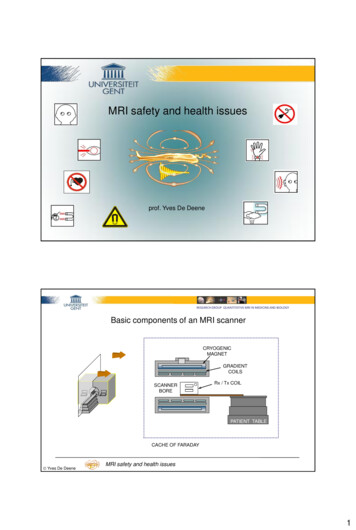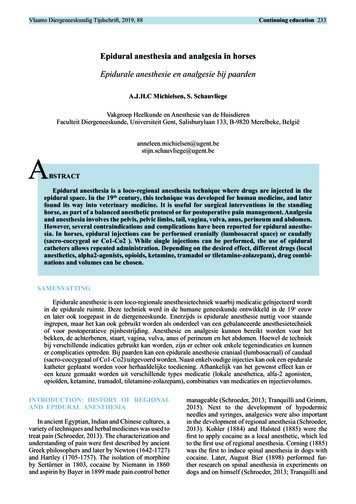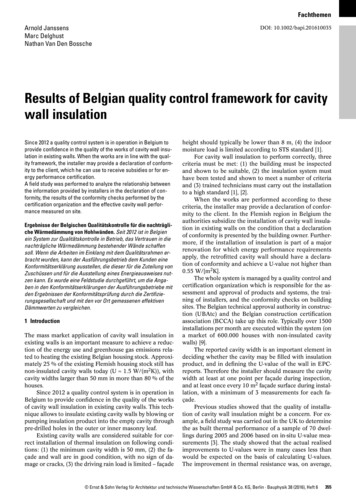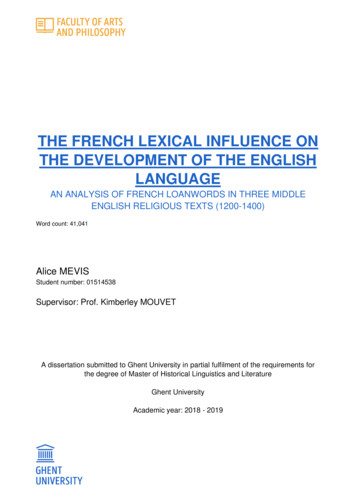
Transcription
Multiple group measurementinvariance analysis in LavaanKate XuDepartment of PsychiatryUniversity of CambridgeEmail: mx212@medschl.cam.ac.uk
Measurement invariance In empirical research, comparisons of means orregression coefficients is often drawn from distinctpopulation groups such as culture, gender, languagespoken Unless explicitly tested, these analysis automaticallyassumes the measurement of these outcome variablesare equivalent across these groups Measurement invariance can be tested and it isimportant to make sure that the variables used in theanalysis are indeed comparable constructs acrossdistinct groups
Applications of measurementinvariance Psychometric validation of new instrument,e.g. mental health questionnaire in patients vshealthy, men vs. women Cross cultural comparison research – peoplefrom different cultures might have differentunderstandings towards the same questionsincluded in an instrument Longitudinal study that look at change of alatent variable across time, e.g. cognition,mental health
Assessing measurement invariance Multiple group confirmatory factor analysis is apopular method for measurement invarianceanalysis (Meredith, 1993) Evaluation on whether the variables of interest isequivalent across groups, using latent variablemodelling method Parameters in the CFA model can be set equal orvary across groups Level of measurement equivalency can be assessedthrough model fit of a series of nested multiple groupmodels
Illustration of MI analysis based on theHolzinger-Swineford study Cognitive function tests (n 301) Two school groups: Pasteur 156Grant-white 145 Three factors, 9 indicatorsx1x2x3x4x5x6x7x8Visual perceptionCubesLozengesParagraph comprehensionSentence completionWord meaningAddition speedSpeed of counting of dotsDiscrimination speed betweenx9 straight and curved capitals Some indicators might show measurement non-invariance due todifferent backgrounds of the students or the specific teachingstyle of the type of schools
Parameter annotations Measurement parameters 6 factor loadingsλ2, λ3, λ4, λ5, λ6, λ7 9 factor interceptsτ1, τ2, τ3, τ4, τ5, τ6, τ7, τ8, τ9 9 Item residualsε1, ε2, ε3, ε4, ε5, ε6, ε7, ε8,ε9 Structural parameters latent means α1, α1, α3 (set to 0) 3 factor variances ψ11 ψ22, ψ33 3 factor covariances ψ12 ψ13, ψ23
Multiple group CFA Pasteur (n 156) Grand-white (n 145)
Summary of steps in measurementinvariance testsconfiguralConstrainedparametersFree parametersFMean ( 0)fl inter res varcomparison modelWeak/loading invariance fl Fmean ( 0)inter res varStrong/scalar invarianceres var Fmean* Weak/loading invariancefl interconfiguralstrict invariancefl inter resFmean* varStrong/scalar invarianceNote. fl factor loadings, inter item intercepts, res item residual variances, Fmean mean of latent variable, var variance of latent variable*Fmean is fixed to 0 in group 1 and estimated in the other group(s)
Evaluating measurement invarianceusing fit indices Substantial decrease in goodness of fit indicatesnon-invariance It is a good practise to look at several model fitindices rather than relying on a single one Δχ2 ΔRMSEA ΔCFI ΔTLI ΔBIC ΔAIC
Identifying non-invariance Modification index (MI) MI indicates the expected decrease in chi-square if arestricted parameter is to be freed in a less restrictivemodel Usually look for the largest MI value in the MI output,and free one parameter at a time through an iterativeprocess The usual cut-off value is 3.84, but this needs to beadjusted based on sample size (chi-square is sensitiveto sample size) and number of tests conducted (type Ierror)
Lavaan: Measurement invariance analysis Data: HolzingerSwineford1939 School type: 1 Pasteur (156) 2 Grand-white (145) Define the CFA modellibrary(lavaan)HS.model 'visual x1 x2 x3textual x4 x5 x6speed x7 x8 x9' semTools fits a series of increasinglyrestrictive models in one model,data HolzingerSwineford1939,group "school")
measurementInvariance(HS.model,data HolzingerSwineford1939,group "school") -configural model (Model 1) -metric MI model (Model 2) - Metric MI achieved: nonsignificant chi-squarechange -scalar MI model (Model 3) - Scalar MI failed - Constrain latent means equalacross groups, but this is nolonger meaningful because ofnon-MI in Model 3.
Measurement invariance:Step 1: Configural invariance Same factor structure in each group First, fit model separately in each group Second, fit model in multiple group but let allparameters vary freely in each group No latent mean difference is estimated
Configural invariance Constrained none
Lavaan: Model 1 configural modelmodel1 - cfa(HS.model, data HolzingerSwineford1939, group "school")summary(model1,fit.measures TRUE)chisqdfpvaluecfirmsea bic7706.822All parameters are different across groups 115.851 48.000 0.000 0.923 0.097
Measurement invariance:Step 2: Weak/metric invariance Constrain factor loadings equal across groups This shows that the construct has the samemeaning across groups In case of partial invariance of factor loadings,constrain the invariant loadings and set free thenon-invariant loadings (Byrne, Shavelson, etal.;1989) Based on separation of error variance of theitems, one can assess invariance of latent factorvariances, covariances, SEM regression paths No latent mean difference is estimated
Weak/metric Invariance Constrained factor loadings
Weak/metric non-invarianceMeaning of the items aredifferent across groups Extreme response stylemight be present for someitems E.g.More likely to say “yes”in a group valuingdecisiveness Or more likely to choose amiddle point in a groupvaluing humility One shouldn’t comparevariances and covariances ofthe scale based on observedscores that contain noninvariant items(Wichert & Dolan 2011)
Lavaan: Model 2 metric MImodel2 - cfa(HS.model, data HolzingerSwineford1939, group "school",group.equal c("loadings") )summary(model2,fit.measures TRUE)Model 1: configural invariance:chisqdf115.851 l 2: weak invariance (equal loadings):chisqdf124.044 a(model1, model2) Model fit index changes are minimal, hence, metric invariance isestablished.
Lavaan: Model 2 metric MImodel2 - cfa(HS.model, data HolzingerSwineford1939, group "school",group.equal c("loadings") )Loadings are the same across groups, but intercepts are freely estimated
Measurement invariance:Step 3: Strong/scalar invariance Constrain item intercepts equal across groupsConstrain factor loadingsThis is important for assessing mean difference ofthe latent variable across groupsIn case of partial invariance of item intercepts,constrain the invariant intercepts and set free thenon-invariant intercepts (Byrne, Shavelson, etal.;1989)Latent mean difference is estimated
Strong/scalar invariance Constrained Factor loadings item intercepts
Strong/scalar non-invarianceA group tend tosystematically give higheror lower item responseThis might be caused by anorm specific to that group For instance in namelearning tests that involveunfamiliar names for agroupThis is an additive effect. Itaffects the means of theobserved item, henceaffects the mean of thescale and the latentvariable(Wichert & Dolan 2011)
Lavaan: Model 3 scalar invariancemodel3 - cfa(HS.model, data HolzingerSwineford1939,group "school", group.equal c("loadings", "intercepts"))summary(model3,fit.measures TRUE)Model 2: weak invariance (equal loadings):chisqdfpvaluecfirmseabic124.044 54.000 0.000 0.921 0.0937680.771Model 3: strong invariance (equal loadings intercepts):chisqdfpvaluecfirmseabic164.103 60.000 0.000 0.882 0.1077686.588anova(model1, model2) Significant χ2 change indicates intercepts non-invariance Modification index can be used to identify which item intercepts are non-invariant
Lavaan: Model 3 scalar invariancemodel3 - cfa(HS.model, data HolzingerSwineford1939, group "school",group.equal c("loadings", "intercepts"))Both intercepts and loadings are constrained across groups, but latent means are estimated
Lavaan: Modification indexmodel3 - cfa(HS.model, data HolzingerSwineford1939,group "school", group.equal c("loadings","intercepts"))modindices(model3)lhs opsepc.noxgroupmiepcsepc.lv sepc.all81x3 1117.717 0.248 0.2480.2060.20685x7 1113.681 0.205 0.2050.1860.186171x3 1217.717 -0.248 -0.248 -0.238 -0.238175x7 1213.681 -0.205 -0.205 -0.193 -0.193 Modification index showed that item 3 and item 7 have interceptestimates that are non-invariant across groups. In the next model, we allow partial invariance of item intercept,freeing the intercepts of item 3 and item 7.
Lavaan: Model 3a scalar invariancewith partial invariancemodel3a - cfa(HS.model, data HolzingerSwineford1939, group "school",group.equal c("loadings", "intercepts"), group.partial c("x3 1", "x7 1"))summary(model3a,fit.measures TRUE)Model 2: weak invariance (equal loadings):chisqdfpvaluecfirmseabic124.044 54.000 0.000 0.921 0.0937680.771Model 3a: strong invariance (equal loadings intercepts),allowing intercepts of item 3 and item 7 to vary:chisqdfpvaluecfirmseabic129.422 58.000 0.000 0.919 0.0907663.322anova(model3a, model2) The scalar invariance model now has partial invariance, thus latentmeans can be compared
Lavaan: Model 3a scalar invariance withpartial invariance (x3, x7)Lavaan: Model 3a Scalar Invariance WITHOUT partial invariance Grant-White school students does better on textual factor ascompared to Pasteur school students After allowing for partial invariance, there is no difference inspeed between Grant-While school and Pasteur school
Measurement invariance:Step 4: Strict invarianceConstrain item residual variances to be equalacross groups Constrain item factor loadings and interceptsequal across groups. In case of partialinvariance constrain the invariant parametersand set free the non-invariant parameters Strict invariance is important for groupcomparisons based on the sum of observeditem scores, because observed variance is acombination of true score variance andresidual variance Latent mean difference is estimated
Strict invariance Constrained factor loadings item intercepts residual variances
Lavaan: Model 4 strict invariancemodel4 - cfa(HS.model, data HolzingerSwineford1939, group "school",group.equal c("loadings", "intercepts", "residuals"),group.partial c("x3 1", "x7 1"))summary(model4,fit.measures TRUE)Model 3a: strong invariance (equal loadings intercepts), allowing intercepts ofitem 3 and item 7 to vary:chisqdf129.422 l 4: strict invariance (equal loadings intercepts item residualvariances)chisqdf147.260 67pvalue0.000cfirmsea0.909 0.089bic7629.796 The chi-square difference is borderline significant (p 0.037), but theBIC and RMSEA showed improvement. Based on the number of tests inthe model, it is probably safe to ignore the chi-square significance This imply that items are equally reliable across groups. If all itemswere invariant, it would be valid to use sum scores for data involvingmean and regression coefficient comparisons across groups
Structural invariances Factor variances Factor covariances (if more than onelatent factors) Regression path coefficients (inmultiple group SEM analysis)
Lavaan: Model 5 factor variances andcovariancesmodel5 - cfa(HS.model, data HolzingerSwineford1939, group "school",group.equal c("loadings", "intercepts", "residuals", "lv.variances","lv.covariances"), group.partial c("x3 1", "x7 1"))summary(model5,fit.measures TRUE)Model 4: strict invariance (equal loadings intercepts item residual variances)chisqdf147.260 67pvalue0.000cfirmsea0.909 0.089bic7629.796Model 5: factor variance and covariance invariance (equal loadings intercepts item residual variances factor var&cov)chisqdfpvaluecfirmsea153.258730.0000.909 0.085bic7601.551 The chi-square difference is not significant (p 0.42), and the RMSEAshowed improvement. The variance and covariance of latent factors areinvariant across groups As a matter of fact, if one does analysis with latent variables, then strictinvariance if not really a prerequisite, since measurement errors are takeninto account of as part of the model
Summarising the MI analysisModel χ2DF CFIRMSEA BICBase Δχ2ΔDF ΔCFI ΔRMSEA ΔBICm1115.851 48 0.923 0.0977707inv none, free fl inter uniq var covm2124.044 54 0.921 0.0937681 m18.193 6-0.002 -0.004-26 inv fl, free inter uniq var covm3164.103 60 0.882 0.1077687 m240.059 6-0.039 0.0146m3a129.422 58 0.919 0.0907663 m25.378 4-0.002 -0.003m4147.260 67 0.909 0.0897630 m3a 17.838 9-0.010 -0.001m5153.258 73 0.909 0.0857602 m40.000 -0.004-17 inv fl inter, free inter(x3 x7) uniq var covinv fl inter uniq,-34 free inter(x3 x7) Fmean var covinv fl inter uniq var cov ,-28 free inter(x3 x7) Fmean5.998 6inv fl inter, free Fmean uniq var cov MI analysis includes a series of nested models with anincreasingly restrictive parameter specifications across groups The same principle applies for longitudinal data Testing measurement invariance of items over time This is a basis for analysis that compares latent means over time, forinstance, in a growth curve model
Measurement invariance– other issues Setting of referent indicator Identify the “most non-invariant” item to use as referentindicator Or set factor variance to 1 to avoid selecting a referentitem Multiple testing issue Analysing Likert scale data Number of categories and data skewness (Rhemtulla,Brosseau-Liard, & Savalei; 2012) Robust maximum likelihood Ordinal factor analysis treating data as dichotomous orpolytomous (Millsap & Tein, 2004; Muthen &Asparouhov, 2002)
Some references1.2.3.4.5.6.7.Sass, D. A. (2011). "Testing Measurement Invariance and Comparing LatentFactor Means Within a Confirmatory Factor Analysis Framework." Journal ofPsychoeducational Assessment 29(4): 347-363.Wicherts, J. M. and C. V. Dolan (2010). "Measurement invariance inconfirmatory factor analysis: An illustration using IQ test performance ofminorities." Educational Measurement: Issues and Practice 29(3): 39-47.Gregorich, S. E. (2006). "Do self-report instruments allow meaningfulcomparisons across diverse population groups? Testing measurementinvariance using the confirmatory factor analysis framework." Medical Care44(11 Suppl 3): S78.Byrne, B. M., R. J. Shavelson, et al. (1989). "Testing for the equivalence offactor covariance and mean structures: The issue of partial measurementinvariance." Psychological bulletin 105(3): 456-466.Millsap, R. E. and J. Yun-Tein (2004). "Assessing factorial invariance inordered-categorical measures." Multivariate Behavioral Research 39(3): 479515.Meredith, W. (1993). "Measurement invariance, factor analysis and factorialinvariance." Psychometrika 58(4): 525-543.Rhemtulla, M., Brosseau-Liard, P. É., & Savalei, V. (2012). When cancategorical variables be treated as continuous? A comparison of robustcontinuous and categorical SEM estimation methods under suboptimalconditions. Psychological Methods, 17(3), 354-373. doi: 10.1037/a0029315
Acknowledgement:Dr. Adam Wagner provided thoughtfulcomments on earlier drafts
Illustration of MI analysis based on the Holzinger-Swineford study Cognitive function tests (n 301) Two school groups: Pasteur 156 Grant-white 145 Three factors, 9 indicators x1 Visual perception










